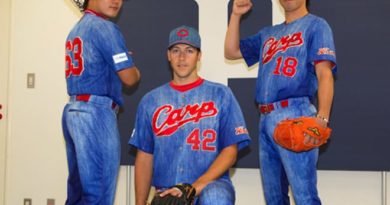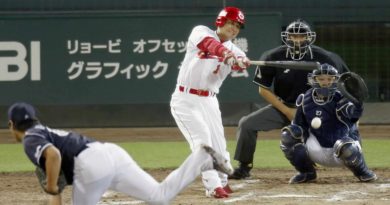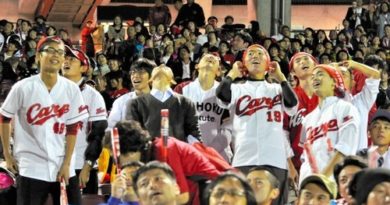The Bad Old Days
 Carp fans sometimes grumble that the team simply can’t keep up financially with the Giants or Tigers. Perhaps they should look at the team’s early history and count their blessings. At least the current team doesn’t have to go out in the street begging for money to pay their players.
Carp fans sometimes grumble that the team simply can’t keep up financially with the Giants or Tigers. Perhaps they should look at the team’s early history and count their blessings. At least the current team doesn’t have to go out in the street begging for money to pay their players.
The source of a lot of the problems for the Carp in the early 1950s was a system where the winning team took 70% of the gate for each game, regardless of where it was played. The Carp were founded in 1950 by local leaders from the Chugoku Shimbun newspaper and Hiroden transit company, and most of their players were local semi-pro and former high school players. Naturally the team was outmatched against established professional teams.
So revenue was slim.

After the last-place 1950 campaign, the team couldn’t afford to travel to Osaka for a preseason tournament, and league officials urged the owners to sell, threatening the Carp with expulsion from the league. But manager Shuichi Ishimoto was determined to make the team survive, and he launched a public fundraising campaign that raised four million yen, saving the Carp, at least for the time being.

In 1951, the Carp again finished last, again with a winning percentage under .300. In the Central League that year, once teams’ places in the standings were determined, irrelevant games at the end of the year were canceled, which meant that the cellar-dwelling Carp had 21 games canceled, depriving them of that revenue, but possibly saving them a bit in payroll.
After the collapse of the team in Fukuoka, the Central League was left with seven teams for 1952, which presented obvious challenges to scheduling, so the league was determined to eliminate one team, and the Carp were a top candidate. Before the 1952 season, the league passed a rule that any team that failed to reach a winning percentage of .300 would be dissolved. As of July 27, the Carp stood at 13-46-2, giving them a winning percentage of .220, and things looked grim. But the pride of Hiroshima rallied, finishing the year at .316 (37-80-3). In its way it was a heroic triumph.
As it happened, Kyoto’s Shochiku Robins finished under .500, and they were thus sent to the chopping block. The Carp lobbied to absorb the weaker team, but were rejected. However, several of the Shochiku players were left as free agents. Normally you would think that Hiroshima could never compete for players on the open market, but the Carp again pulled out their secret weapon, the people of Hiroshima. A public fundraising campaign raised 14 million yen to sign three Japanese free agents and two American players.
As the years went by, the Carp gradually solidified their precarious position. Changes to league revenue rules guaranteed the home team 60% of the gate for each game, and the city agreed to build a stadium right in the center, near the A-Bomb Dome. In 1968, the Matsuda family stepped in as owners as well as sponsors, and the link with Mazda made the Carp a stable franchise.
Read more posts by Tim Buthod or check out all our posts about the Hiroshima Toyo Carp.




